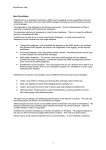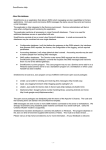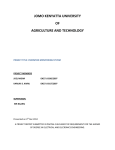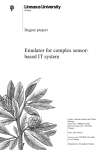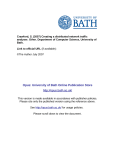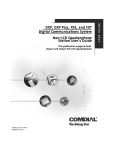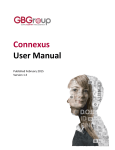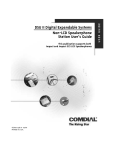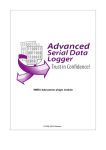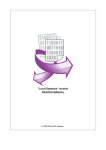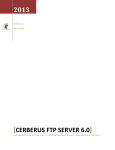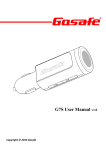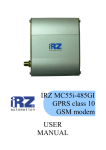Download Sms4Domino - Help V1.0
Transcript
Sms4Domino Help
About this database
Sms4Domino is an application that delivers SMS (short messaging service) capabilities to Domino
applications. End users send and receive SMS messages the same way as they send and receive
e-mail messages.
The application is fully integrated in the Domino environment . Domino administrators will feel at
ease when configuring and monitoring the application.
The application performs all processing in Lotus Domino databases . There is no need for additional
servers or specialised skill sets .
Sms4Domino consists of one or more Lotus Domino databases. In small environments the
databases may be combined into one single database.
Configuration database (.nsf) that defines the gateways to the GSM network, the interfaces
that generate SMS requests, the license, the configuration of the logging, and all required
parameters.
Accounting database (.nsf) where historical data is stored. Accounting records may be used
to restrict people from sending SMS messages.
SMS mailbox databases. The Domino router stores SMS requests into this database.
Sms4Domino polls the database, converts the requests into SMS messages and transmits
them via one of the defined gateways.
Sms4Domino run time program. This Java program may run as a Domino server add-in on a
Windows based Domino server or as a standalone program on a workstation on which Lotus
Notes has been installed.
Sms4Domino is build as a Java program on top of different well known open source packages :
smslib: Java toolkit for sending and receiving Sms messages (http://smslib.org)
log4j: Java logging framework (http://logging.apache.org/log4j/1.2/)
JAddin: Java toolkit for Domino Add-In Server tasks (http://abdata.ch/JAddIn.html)
libphonenumber: Google's phone number handling library, powering Android and more (
http://code.google.com/p/libphonenumber)
The open source packages are distributed under the terms of the Apache V2 license. The code and
the licensing terms are stored in the Sms4Domino template.
SMS messages are sent via one or more GSM modems connected to the server or workstations. We
strongly recommend using industrial grade modems connected via a serial COM port . (Only the
Cinterion MC55iT modem is supported).
Sms4Domino has been developed on a Domino 8.5 platform on Windows. The program depends on
the Java run time environment supplied with Domino or Notes. This must be at least version ....
Please visit us at http://www.sms4domino.eu for more information. All your feedback is welcome.
-1-
Sms4Domino Help
Revision history
The version of the software is printed when the application is started .
Version
Description
1.0 (March 2012)
- Initial production release
Inbound and outbound SMS messages
Inbound routing via fixed routing or auto matching
Restrictions on allowed destination phone numbers
Content of outbound SMS message may be changed at run-time via
@formula
For use with Cinterion MC55iT GSM Quad Band Modem
0.1 (January 2012)
- Initial internal release
Only outbound SMS messages
-2-
Sms4Domino Help
System architecture
Sms4Domino integrates in any Domino infrastructure. Following drawing illustrates the
architecture when Sms4Domino is running as a server addin. Typically the configuration
database and Sms4Domino are located on the same server. One or more modems are
connected via COM ports to the Domino server. End users and systems may send mail from
different kind of workstations anywhere in the network. Domino will route the mail to
Sms4Domino.
As an alternative Sms4Domino may run on a Windows workstation. The modems are connected
to the COM ports of the workstation. The configuration database resides on any of the Domino
servers.
-3-
Sms4Domino Help
-4-
Sms4Domino Help
Limitations of this release
Some features that are described in the help file or on the configuration settings have not yet been
implemented.
Sms4Domino may be rolled-out as a multi-database application (configuration database,
accounting database, ...). In the current release all Sms4Domino features must be part of a
single database.
Not all Interface families have been implemented. In the current release requests for
sending a SMS must be mailed to Sms4Domino.
Only one Notes Mail Interface may be defined. This implies that there is only one foreign
domain document related to SMS messages. (Of course is is possible to run multiple
instances of Sms4Domino on different machines, each using a dedicated configuration
database)
Not all gateway families that are supported by SmsLib are available for being used by
Sms4Domino. Currently we recommend connecting an industrial modem via a serial cable
to a COM port. Multiple modems may be connected to the same machine. All modems must
be connected to the machine where Sms4Domino is running.
-5-
Sms4Domino Help
30 minute installation guide
The installation should be straightforward for a Lotus Domino system administrator .
Before you begin
Acquire one or more industrial grade GSM modems (e.g. Cinterion MC55iT) and a SIM card.
(During the development of Sms4Domino we tested many different modems. Although they
should all implement the same set of AT commands we have experienced subtle differences
in the way this is done. Sms4Domino support for modem related issues is therefore
available for this modem only.)
Connect the modem(s) to the serial port(s) on the computer. Consider installing a PC card
with multiple serial ports. (It is also possible to connect the modem, via a serial-to-ethernet
convertor, directly to the LAN. This setup is documented in a separate help document)
Test the communications between the PC and the GSM modems. Windows provides some
basic test tools.
Prepare the modem for use with Sms4Domino.
Decide on the architecture. Sms4Domino may run as a Domino server add-in (started via
RunJava) or as a standalone program on a PC where Lotus Notes clients has been installed.
-6-
Sms4Domino Help
Installation steps
This document contains only a checklist of all installation steps . More information is available in
subsequent documents.
1. Obtain a copy of the Sms4Domino template. Sign the template with a proper user id.
2. Create a configuration database on a Domino server. (The database must always reside on
a server - not on a workstation). Adjust the ACL settings.
3. Extract the dll and jar files from the configuration database and install them in the appropriate
directories on the server or workstation where Sms4Domino will be running.
4. Add some mandatory parameters to the notes.ini of the server or workstation where
Sms4Domino will be running.
5. Define the basic parameters in the application profile of the configuration database .
6. Create and configure gateway documents. Every transmission path to the GSM network
requires a gateway document.
7. Create and configure interface documents. Each source of SMS requests requires an
interface document. Domino mail interfaces may receive the Domino mails in the
configuration database or in a separate database. In all cases it is the most practical to base
the databases on the Sms4Domino template.
8. Create and configure a license document. Obtain a valid license file from Sms4Domino and
copy the contents of the file into the license document.
9. Create and configure logging documents. Logging is based on the Apache log4J software.
Logging may be very tearse of verbose. Output of the logging may be directed to the Domino
log.nsf or to a Windows file.
10. Define a foreign domain in the Domino directory. Notes users will address mails to
John@3618319@sms or to 3618319@sms for sending a SMS message to this number. De
mailbox of the foreign domain points to the Sms4Domino control database or another
database that has been defined in the interface document.
11. Start the Sms4Domino program.
The system is now ready to be used. The administrator should
Monitor the system.
Perform maintenance actions.
-7-
Sms4Domino Help
Choice and installation of the modem
Sms4Domino is running on top of SmsLib. This software is responsible for the communication with the modem .
SmsLib supports different kind and models of modems like a USB connected GSM , an industrial modem
connected via a serial COM port, a modem directly connected to the LAN or a SMS service provider like
Clickatel.
In the current release Sms4Domino only supports a local or LAN connected modem . We recommend using an
industrial grade modem connected to a serial port (not via USB, bluetooth or infrared). During testing we have
noticed that not all modems are equal. They may behave in unexpected ways under certain conditions . In order
to receive support for modem related questions you should use the Cinterion MC 55iT modem (
http://www.cinterion.com). In case the modem must be connected to the LAN we recommend the use of the
ABLELink Ethernet Serial Server (Atop technologies - http://www.atop.com.tw)
Modern PCs have no are only one COM port. It may be necessary to install an expansion board providing one ,
two or more additional COM ports. These cards come mostly with driver software . After a successfull
installation the COM ports must be visible in the Windows device manager
After this verification it is possible to connect the modem to the COM port . Read the documentation supplied
with the modem. You must know the communication speed and parameters between the PC and the modem .
Sms4Domino will communicate with the modem at a configurable speed . However Sms4Domino will
communicate with following settings
Speed: defined in the gateway document. Modems operate either at a fixed bit rate or may recognize
automatically the bit rate being used. This auto bit rate recognition feature does not work if the speed is
too high or too low. Consult the documentation supplied with the modem .
8 databits
1 stop bit
no parity bit
Flow control based on RTS and CTS
When the modem is connected to the PC it is recommended to perform some basic communication tests . There
are different ways for doing this. We explain a few of them.
Windows modem test
Open the Windows control panel. Click on Phone and modems. Add a generic modem to the COM port
(COM5 in the print screen)
-8-
Sms4Domino Help
-9-
Sms4Domino Help
The modem may be tested via the query tool under the Diagnostics tab .
- 10 -
Sms4Domino Help
COM test program
The next example is based on the Advanced Serial Port monitor (evaluation version available on
http://www.aggsoft.com).
- 11 -
Sms4Domino Help
The program must be started in administrator mode . Open the port at the speed configured in the modem .
Send the AT command to the modem. The modem should respond with OK.
- 12 -
Sms4Domino Help
Putty (http://
http ://www
:// www.
www .putty .org)
org )
Putty is a free open source telnet client . It is normally used to communicate with devices connected to the
LAN. However, in serial mode, it is perfectly suited to test the modem connected to the com port .
Download putty to your local Windows machine . Executy the putty.exe program
- 13 -
Sms4Domino Help
Configure your session (Clickon Session in the left pane)
Connection type = serial
Serial line = the COM port you are using
Speed = the default speed for your modem
- 14 -
Sms4Domino Help
Specify additional settings for the serial connection (click on Connection -> Serial in the left pane)
Data bits: 8
Stop bits: 1
Parity: None
Flow control: RTS/CTS
You are now ready to test the connection with your modem . Click on open. The modem should respond
with OK to the AT command
- 15 -
Sms4Domino Help
- 16 -
Sms4Domino Help
Initial configuration of the Cinterion MC 55iT
55iT modem
Sms4Domino assumes the modem has been properly initialized. This is true for a Cinterion modem
that uses the factory default settings. However, when a modem is moved from some other project to
Sms4Domino it may be necessary to change some modem settings.
Changing the settings is done by sending AT commands to the modem. We prefer connecting the
modem directly to a serial port. Trying to connect the unknown modem to the serial-to-Lan convertor
and then trying to talk to the modem over the LAN is not recommended.
This document assumes you are using Putty for communicating with the modem.
Following steps will be executed
Establish communication with the modem. It may be necessary to guess the baud rate
Reset the modem to the factory defaults
Set the required modem parameters
Save the parameters to non volatile RAM. After each reboot of the modem these settings will
be loaded automatically into memory.
Verify the PIN code of the SIM card
Establish communication with the modem
Find in the office a computer with a COM (RS-232) port. Determine the identifier of the COM
port. In most cases this will be COM1. The Windows device manager lists all known ports
Connect the modem to the COM (RS-232) port using a quality RS-232 cable.
Launch the putty program
- 17 -
Sms4Domino Help
Within the Session category select the COM port (COM4 in above example) and the speed.
57600 bps will be recognized by the modem if AutoBauding is still enabled . Acceptable speeds
for the Cinterion modem are 300, 600, 1200, 2400, 4800, 9600, 14400, 19200, 28800, 38400,
57600, 115200 and 230400 bits per second. AutoBauding is only possible for speeds up to
115200 bps.
- 18 -
Sms4Domino Help
Within the Connection -> Serial category specify the settings for data bits, stop bits, parity and
flow control. Factory default settings are 8 data bits, 1 stop bit, no parity and no flow control.
Click Open. A pop-up window is displayed.
- 19 -
Sms4Domino Help
Enter the letters AT followed by pressing Return. The could be an echo of AT. The modem
should respond with OK
If there is no respons from the modem you should verify your settings.
Reset the modem to the factory defaults
The AT&F command resets all modem parameters to the manufacturer defined profile. The
modem response should be OK.
The AT&V command lists the current parameters. Consult the Cinterion AT command guide for
more info.
- 20 -
Sms4Domino Help
Set the required modem parameters
The modem communication will be more reliable if autobauding is not used . The bit rate is
specified by the
AT+IPR=<rate>
command. Values of <rate> are 0 for autobauding, 300, 600, ...., 57600, 115200, 230400.
The setting will not be changed by the above AT&F command.
The current bit rate may be queried by the AT+IPR? command
- 21 -
Sms4Domino Help
Flow control between the computer and the modem must be set to hardware flow control (using
RTS/CTS).
Hardware flow control must be set on both sides: with AT\Q3 in the ME and an equivalent
RTS/CTS handshake option in the host application.
The default setting of the modem is AT\Q0 (no flow control) which must be altered to AT\Q3
(RTS/CTS hardware handshake on). The setting is stored volatile and must be restored each
time after rebooting the ME.
AT\Q has no read command. To verify the current setting of AT\Q, simply check the settings
of the active profile with AT&V.
- 22 -
Sms4Domino Help
Later, when configuring the Sms4Domino environment and gateways, you should define the same
parameter settings.
Save the settings to non volatile RAM
The AT&W command is used to store the settings to non volatile RAM. The modem responds with
OK.
Sms4Domino will issue the ATZ command as one of the first commands to load the settings into
memory.
- 23 -
Sms4Domino Help
Verify the PIN code of the SIM card
Power down the modem. Insert a valid SIM card. You should have received a corresponding PIN
code.
The AT+CPIN write command can be used to enter one of the passwords listed below. The read
command can be used to check whether or not the ME is waiting for a password, or which type of
password is required. This may be for example the SIM PIN1 to register to the GSM network, or
the SIM PUK1 to replace a disabled SIM PIN1 with a new one, or the PH-SIM PIN if the client has
taken precautions for preventing damage in the event of loss or theft etc. If requested by the ME
AT+CPIN may also be used for the SIM PIN2 or SIM PUK2.
If no PIN1 request is pending (for example if PIN1 authentication has been done and the same
PIN1 is entered again) MC52i responds "+CME ERROR: operation not allowed"; no further action
is required.
Each time a password is entered with AT+CPIN the module starts reading data from the SIM. The
duration of reading varies with the SIM card. This may cause a delay of several seconds before all
commands which need access to SIM data are effective.
We could further verify that the modem has been properly registered to the GSM network. Enter
the
AT+COPS?
command.
- 24 -
Sms4Domino Help
Appendix: Cinterion AT command guide
mc52i_atcommands_v01201a.pdf
- 25 -
Sms4Domino Help
Configuration of the ATOP SE 5000 Serial server
In case no COM ports are available or when the GSM modem should be located outside the
computer room it possible to connect the modem to a serial server. This device acts as a gateway
between the Ethernet LAN and the COM modems. The configuration of the serial server is
documented in the user guide.
The current help document guides you through the setup. Following steps must be executed
Connect the serial server to the LAN
Assign a fixed IP address to the serial server
Configure the serial server
Save the settings
Test the setup via a Telnet connection
Connect the serial server to the LAN
The serial server has following factory settings
IP address: 10.0.50.100
Subnet mask: 255.255.0.0
Default gateway: 10.0.0.254
DHCP client: disabled
User name: admin
Password: <null> (leave the password field blank)
Use a paperclip to push the reset button for a few seconds. You will hear some beeps. This
resets the serial server to the factory default settings.
Configure the Ethernet port of your (test) computer with compatible IP settings. E.g.
- 26 -
Sms4Domino Help
Connect the serial server to your computer. You need two straight cables and a switch or you
could use a crossed cable and make a direct connecten between you PC and the serial server.
Test the connection by ping-ing the serial server.
The serial server may be configured via the command line or using a browser . Internet Explorer
should be used.
Enter http://10.0.50.100 as Url.
- 27 -
Sms4Domino Help
- 28 -
Sms4Domino Help
Assign a fixed IP address to the Serial Server
Ask your network administrator for a free IP address that is compatible with your network
addressing scheme. The address may be assigned via DHCP or may be entered as a fixed
address in the device. Sms4Domino requires the knowledge of this address.
Enter the new address in the Networking section
- 29 -
Sms4Domino Help
Click on Save Configuration followed by Restart.
You are now ready to connect the serial server to the LAN. Further configuration steps must be
using the above assigned IP address.
Configure the serial server
Following instructions must be repeated for each of the COM ports. In the example we will
configure COM1.
- 30 -
Sms4Domino Help
Sms4Domino supports TCP/IP connected modems. There is no need for special driver software
that must be installed in Windows.
The serial server must be configured with following settings
TCP Server
Enable VirtualCOM for Serial/IP: No
Pair Connection: No
Reverse Telnet Mode: No
Local Listening Port: 4660 or any other value. The same value must be specified in the
Sms4Domino gateway definition document
IP filter: this is a security feature. Only the Sms4Domino server should be allowed to
communicate with the serial server.
Enabled: Yes
Source IP: specify the IP address of the Sms4Domino server
Idle Time before sending TCP Alive packet: Sms4Domino assumes the TCP/IP connection
remains open. Enter 2 for 20 seconds
TCP Inactivity Time: in case of a failure of Sms4Domino the connection should be broken.
Specify 60. This value should be higher than the watchdog interval specified in the
application profile (SmsLib settings)
Following set of parameters correspond to the physical COM interface . The settings must be the
same as the ones that have been configured in the modem.
Alias Name: for your own documentation
Baud rate: 57 600 (this is the default for the Cinterion modem)
Parity: none. (this is the default for the Cinterion modem)
Data bits: 8. (this is the default for the Cinterion modem)
Stop bits: 1 bit. (this is the default for the Cinterion modem)
Flow control: RTC/CTS (this is the default for the Cinterion modem)
Empty Serial Buffer: Yes
Data Packet Delimiter: this parameters determines at what moment data received from the
modem should be transmitted to Sms4Domino. There is no fixed terminator character that
applies to all responses. The only acceptable data packet delimiter is based on the
inter-character time gap. A value of 15 msec should be fine.
- 31 -
Sms4Domino Help
COM Type Selection: RS232
Click the Save button to save the settings.
Test the connection
We assume the modem has already been configured. Connect the modem to the COM port of
the serial server.
Open a Dos box and enter the command (assuming the serial server is configured for IP address
10.0.50.100 and to listen on port 4660)
telnet 10.0.50.100 4660
The Dos window is cleared. Type AT. The modem should respond with OK
After the configured idle time the connection is closed automatically .
The same test could be performed using Putty. The connection type must be set to Raw.
- 32 -
Sms4Domino Help
Appendix: Atop user guide
SE5002 Serial- Ethernet User's Manual (V1.3).pdf
- 33 -
Sms4Domino Help
Decide on the architecture
Sms4Domino may be deployed in different configurations. However the program, as the name
implies, always require the presence of a Domino server.
Running the Sms 4Domino program as a server add -in
Sms4Domino is a Java program. The program should run continuously. As Domino agents
are limited in execution time it is not possible to run the program as an agent .
Sms4Domino may run as a Domino add-in task. The program is started via the load runjava
Sms4DominoAddin console command (case sensitive). All input/output between the Domino
administrator and the program goes via the Domino (remote) console. As a shortcut the
program may also be started using the load runjava Sms console command.
In order to run a Java program as a server add-in command Sms4Domino makes use of the
open source software JAddin (http://abdata.ch/JAddIn.html). This kind of integration has not
been certified by IBM. Till today we have not yet experienced any problems.
The GSM modems are attached to the Domino server.
The main advantage of this configuration is the integration of the input/output with the Domino
console and log.nsf file. It is possible to use the Domino remote console to interact with the
program. The program may be started using Domino program documents or notes.ini
settings.
Running the Sms 4Domino program as a standalone program
Sms4Domino may run as a stand-alone program on a workstation. Lotus Notes must have
been properly installed and configured on the workstation. Sms4Domino will access the
Domino server using the credentials of the current Lotus Notes user-id (defined in notes.ini by
the KeyFileName variable). The password must be supplied as a start-up parameter or the
user id must have no password.
Sms4Domino will create a console for interacting with the administrator .
- 34 -
Sms4Domino Help
The GSM modems are attached to the workstation. The configuration database must be
installed on the Domino server.
This set-up does not depend on the JAddin program. However there is no integration with the
Domino logging, no possibility to use the remote Domino console and supplying the Notes
password via the command line may be less than ideal. In case the Domino server is stopped
or the network connection becomes broken, Sms4Domino will not be able to continue, will log
errors to the console and, in most cases, must be restarted in order to recover from the failure.
Databases
The main database is the configuration database. It contains the application profile, the
license file and the configuration documents for the gateways and the interfaces. The
database is based on the Sms4Domino template. The database must be located on a Domino
server and not on a workstation.
In most cases requests for sending Sms messages are created via Lotus Notes mail
messages (received by the Notes mail messages interface). The Domino routing
configuration requires the definition of a foreign domain document. The foreign domain
documents defines a gateway file name. This could be the configuration database or a
separate database. The database should always be based on the Sms4Domino template.
We recommend using a separate database.
Sms4Domino may generate accounting documents. These documents provide a view on the
Sms volume, over a period of time, for a user, a gateway or an interface. The accounting
information may also be used to block a user from sending more Sms messages. The
- 35 -
Sms4Domino Help
accounting documents may be stored in the control database or in a separate database. The
database is based on the Sms4Domino template. We recommend using a separate database.
- 36 -
Sms4Domino Help
Installation of the databases
TheSms4Domino software is shipped as a set of two Domino databases : the Sms4Domino template
and the help file. The template is a common template that must be used for all Sms4Domino related
databases.
The files may be delivered on a CD, by e-mail or may be downloaded from the Internet. The
Sms4Domino template database is distributed as a Notes template file (.ntf). The help database is
distributed as a standard Notes database file (.nsf).
The databases may only be accessed by a Notes client and not by a web browser.
The current version of the template is 1.0.
Get a copy of the databases. Unzip the files if required.
Copy the template to your local Lotus Notes data directory. By preference this should not be
done on the Domino server but on a workstation of the administrator. Do not forget to
remove the "read-only" attribute that may be present at the level of the operating system.
The ACL settings of the template grants full access to all users. This may be changed
according to your company policy settings.
Sign the template using the Notes user-id of the administrator in order to avoid any future
ECL warnings. This user-id should have sufficient access rights to run Lotusscript agents .
- 37 -
Sms4Domino Help
You could be prompted for the creation of a cross-certificate in your address book. Click No.
Use the Notes client to copy the template to the Domino server. The template on the
workstation is then no longer needed.
Create a configuration database from this template. The database must be stored in the data
directory or a subdirectory on the Domino server. The title and file can be any valid name.
(In the help document Notes.ini settings you will learn how to tell Sms4Domino where to find
this configuration database). The license file that is required to run Sms4Domino is based
on the server name where the configuration file is located. Moving the configuration
database to another server requires the presence of a new license file.
Modify the default ACL of the database. Details of the ACL settings may be found in the
document ACL Settings of the application.
Some database properties for this database
When opened in the Notes client : Open designated frameset Main1
When opened in a browser : Open designated page AccessForbidden
Full text index is not required
Copy the help file to your local Lotus Notes data directory. By preference this should not be
done on the Domino server but on a workstation of the administrator. Do not forget to
remove the "read-only" attribute that may be present at the level of the operating system.
Sign the database using the Notes user-id of the administrator in order to avoid any future
ECL warnings.
Use the Notes client to copy this database to the Domino server. The copy must be stored in
the data directory or a subdirectory on the Domino server. The file name can be any valid
name. The database on the workstation may be deleted. (In the help document Application
- 38 -
Sms4Domino Help
profile settings -> General settings you will learn how to make a link between the
Sms4Domino configuration database and the help database).
Modify the ACL of the database. The default ACL grants manager level access to all users.
Standard users should have read only access.
A full text index is recommended on the help database.
In case separate databases are used for the accounting documents and/or the foreign
domain mailbox the procedure for creating the configuration database must be repeated.
The application profile in these databases contain a link to the main configuration database .
- 39 -
Sms4Domino Help
ACL Settings of the Sms 4Domino configuration database
This database is the central point for the application. It contains all configuration settings and
eventually queues of Sms requests, accounting data, ...
This database should not be accessible by unauthorised users. It should get the same level of
protection as the Lotus Domino directory.
Access to the application is controlled by access levels and roles in the ACL .
The available roles and their purpose are explained in following table .
Role
[DBAdmin]
Purpose
- grants write access to the application profile
- grants access to the run-time dll files
- grants author level access to all documents
- this role is normally assigned to a single administrator , responsible for the
set-up of the software
- the owner of the role should have Author level access or higher in the
ACL
Recommended ACL settings for the server
Manager level access (at least editor level access is required )
All roles enabled
Recommended ACL settings for administrators
Author level access
Delete documents
Recommended ACL settings for the user -id running Sms 4Domino
When running Sms4Domino as a server add-in this user-id is the server-id. When running
Sms4Domino as a standalone program this user-id is the id specified by the notes.ini entry
KeyFileName. This corresponds to the user-id that was used the last time Lotus Notes was
started.
Manager level access (at least editor level access is required )
All roles enabled
Recommended ACL settings for web users
No access (the database has not been designed for web access)
No roles enabled
- 40 -
Sms4Domino Help
- 41 -
Sms4Domino Help
Installation of the runtime files
Sms4Domino is a Java program that may run as a server add-in or as a standalone program. The
program depends on some open source libraries (see the document About this database in the
current help file). All code has been packaged in a few jar files Sms4Domino.jar and the jar files of
the open source components.
Java must be able to communicate with the GSM modems over the serial COM ports. One dll file is
required. There is a specific file for 32 bit Windows and another for 64 bit Windows.
All runtime files may be found in the configuration database via the menu System -> Runtime files .
You need the [DBAdmin] role in order to access the page containing the runtime files.
Procedure
1. Open the Sms4Domino Configuration database.
2. Select System -> Runtime files in the left navigation pane. A page containing the jar and dll
files opens.
3. Open the Windows 2003 - Windows 2008 bit section.
4. Detach all files into the specified directories on the machine where the Sms 4Domino
program will be running.
5. Close the window.
- 42 -
Sms4Domino Help
Notes.
Notes .ini settings
Most of the run time parameters for the Sms4Domino software are specified in Lotus Notes
documents in the configuration database. However, when Sms4Domino is started, it must know
where to find the configuration database.
This is achieved by two mandatory notes.ini settings. When Sms4Domino is running as a server
add-in the notes.ini of the server must be modified. When Sms4Domino is running as a stand-alone
program the notes.ini of the Notes client must be modified.
The notes.ini of the Domino server may be modified by editing the file directly . However, it is
recommended to specify the settings in a configuration document in the Domino directory . The
notes.ini of a workstation is edited using a plain text editor like Notepad .
The list of available notes.ini parameters is specified in following table . The parameters are not
case-sensitive. Some of the parameters are mandatory !
Parameter
Sms4DominoConfigDB
Purpose
This parameter specifies the location of the Sms4Domino configuration
database. This database resides in the Domino data directory or one its
subdirectories.
The parameter must be specified as a relative file name. The
parameter is case sensitive on some platforms (e.g. Unix)
Example :
Sms4DominoConfigDB=Sms4Domino\configdb.nsf
Default value: sms4Dcfg.nsf
Sms4DominoServer
This parameter specifies the hierarchical name of the Domino server
where the configuration database resides.
In case the parameter is not specified the filter assumes the database
resides on the current server.
Example :
Sms4DominoServer=Acme/SVR/Comp
Validation of the license file is only possible if the configuration
database is located on a Domino server.
Sms4DominoConsoleWidth These two parameters are only used when Sms4Domino is running as a
Sms4DominoConsoleHeig stand-alone program. They define the width and height, expressed in
ht
pixels, of the console used for logging and entering commands.
The open console may be resized by the Windows user. When
Sms4Domino is stopped the current console size is saved into these
two environment variables.
Example :
Sms4DominoConsoleWidth=1000
Sms4DominoConsoleHeight=500
- 43 -
Sms4Domino Help
Application profile settings
Most of the global parameters of the Sms4Domino software are specified in the application profile in
the configuration database. This document is mandatory and must be created by the database
administrator. You need manager level access to create such a profile.
You should close the Notes configuration database after any modification of the application profile .
It is required to stop and restart Sms4Domino in order to make the modifications to the application
profile visible to Sms4Domino.
Procedure
1. Open the Sms4Domino configuration database.
2. Select System -> Application Parameters in the navigator. The profile document is opened
in edit mode
3. Verify all default settings and modify them if necessary . Default settings may be restored at
any time by clicking the Tools action button. More detail is provided in the following help
pages.
4. Click Save and Close to update the settings.
- 44 -
Sms4Domino Help
Sms4
Sms 4Domino Server Settings
This section contains global settings that are used by Sms 4Domino.
Parameter
Autostart server
Purpose
When Sms4Domino is launched, either as an addin or as a standalone
program, it is ready to accept console commands. (The Help command
displays a list of available commands ). However the Sms server is not yet
started by default. This allows the administrator to launch some test
probes on the modems.
By setting the Autostart server parameter to enabled the Sms server is
started automatically as soon as Sms4Domino is launched. In production
environments this should be the normal mode of operations.
Values
Enabled: this is the recommended value
Disabled
Delete messages from
GSM modem
GSM modems may keep a list of all outbound SMS messages in their
internal memory. When this memory is full the modem may refuse to
accept further messages.
Sms4Domino may delete the Sms from the memory of the modem after
transmission.
Values
Enabled: this is the recommended value
Disabled. The same message will be received multiple times from the
modem.
Inbound polling interval
The inbound direction is defined as from the GSM network into
SMS4Domino.
Sms4Domino is based on SmsLib for sending and receiving Sms
messages. SmsLib places inbound SMS messages (received from the
GSM network) into an internal queue. This queue is polled by
Sms4Domino every Inbound interval seconds.
Setting a value too high may result in end users complaining about late
reception of their SMS messages.
Setting a value too low may impose unnecessary load on the server.
Recommended value: 30 seconds
Outbound polling interval The outbound direction is defined as from Sms4Domino to the GSM
network;
Requests for sending SMS messages may come from different sources.
Every source is implemented by an interface. The interface places the
request into an internal queue. Sms4Domino polls the queue every
outbound interval seconds.
Interfaces may accelerate the polling process by sending a signal to the
polling process. As a consequence it is allowed to have a rather large
outbound polling interval.
Recommended value: 300 seconds
Outbound queue depth
Sms4Domino pushes outbound SMS requests into the queues managed by
SmsLib. This parameter specifies how many outbound requests may be at
any time in the SmsLib queues. In order to have an optimal throughput the
- 45 -
Sms4Domino Help
queue should not be left empty when there are still outbound SMS requests
present within the interfaces.
Pushing too many requests into SmsLib may result in a memory overload.
In case of a server crash the messages will be pushed again into the
queue when Sms4Domino starts again.
Recommended value: 2 * the number of outbound modems (outbound
gateways)
Low priority time zone
Low priority SMS messages are sent after high and normal priority
messages but may be sent at any time during the day. This setting is not
used in the current release.
Accounting records
Each time an outbound SMS message has been transmitted an accounting
record may be generated. Accounting records may be used for internal
billing processes and give management a detailed view on the use of the
server.
The detailed accounting records are further aggregated into aggregated
accounting documents. These aggregated figures may be used (not yet
implemented) in order to impose restrictions on users for sending further
SMS messages.
Values
Generate accounting records: this is the recommended value
No accounting records
Accounting database
Accounting documents - if enabled - are created in the configuration
database or another database. Either way, the database must be based on
the Sms4Domino template.
Specify the filepath, relative to the Domino data directory, where the
database resides. The database must be located on the same server as
the configuration database.
Values
leaving the field empty implies that the configuration database is used
for storing accounting records. This is the mandatory setting for the
current release.
filepath (e.g. Sms4Domino\accounting.nsf) to specify a dedicated
database
- 46 -
Sms4Domino Help
SmsLib Settings
Sms4Domino runs on top of the open source SmsLib library (available at smslib.org). Parameters of
SmsLib are documented on the web site smslib.org. For convenience reasons the documentation
has been copied into this help document.
SmsLib parameters are normally defined via java properties files . In a Domino environment
administrators prefer to define parameters in Notes fields on Notes documents. Sms4Domino reads
the settings from the application profile and translates them internally into SmsLib properties .
Parameter
SERIAL_NOFLUSH
Purpose
If true, SMSLib will not call the flush() system call upon writing to the serial
port. This should normally be left as false, meaning that we need the flush()
call. Set it to true for Linux/RxTx and virtual ports where the flush() call
leads to errors
Default: false
SERIAL_POLLING
If false, SMSLib will rely on the serial port interrupts to wake up and get
incoming data. If true, if will create a separate thread in order to
periodically poll the serial port for incoming data . Set it to true only on
Linux/RxTx installations if you see that SMSLib behaves as if no modem is
connected.
Default: false
SERIAL_POLLING_INT This is the polling interval . It has a meaning only when the
ERVAL
SERIAL_POLLING is true, i.e. SMSLib works in polling mode. The value is
in milliseconds. The default value is a good starting point - you may
experiment with different values
Default: 200ms
SERIAL_TIMEOUT
This is the master timeout set on the serial ports. The value is in
milliseconds.
Default: 30 000ms
SERIAL_KEEPALIVE_IN This is the keep-alive interval. The keep-alive functionality in SMSLib
TERVAL
periodically "pings" the modem in order to keep the connection active. The
value is in seconds.
Default: 60 s
SERIAL_BUFFER_SIZE This is the buffer size SMSLib uses for the internal queues. The value
represents characters (bytes).
Default: 16 384 bytes
SERIAL_CLEAR_WAIT This is a delay value, used when clearing the queues. The value is in
milliseconds.
Default: 1 000 ms
SERIAL_RTSCTS_OUT If set, RTS/CTS will be enabled for outbound serial traffic as well . Useful
for some types of phones
- 47 -
Sms4Domino Help
Default: false
QUEUE_RETRIES
The retry count of the background queue manager for a message failing to
be sent out. After this retry count, the queue manager will stop trying
sending this message.
Default: 3 times
AT_WAIT
This is a delay value, used after some AT commands. The value is in
milliseconds.
Default: 200 ms
AT_WAIT_AFTER_RES This is the delay value. SMSLib will sleep for this period after issuing a modem
reset command, in order to give time to the modem to initialize. The value is in
ET
milliseconds.
Default: 10 000 ms
AT_WAIT_CMD
This is a delay value, representing the time needed after issuing a "+++"
command. The value is in milliseconds.
Default: 1 100 ms
AT_WAIT_CGMS
This is a delay value, representing the time needed after issuing a "CMGS"
command. The value is in milliseconds.
Default: 200 ms
AT_WAIT_NETWORK
This is a delay value, representing the time that SMSLib will give modem in order
to attach to the GSM network. The value is in milliseconds.
Default: 5 000 ms
AT_WAIT_SIMPIN
This is a delay value, representing the time that SMSLib will give modem after the
SIM PIN initialization. The value is in milliseconds.
Default: 5 000 ms
CNMI_EMULATOR_INTER If CNMI fails, SMSLib will launch a separate thread for periodically polling the
VAL
modem for inbound messages and still act as an asynchronous reader.
Default: 30 s
OUTBOUND_RETRIES
This is the retry count, defining how many times SMSLib will try to send a failing
message. After those retries, message will be marked as failed.
Default: 3 times
OUTBOUND_RETRY_WAI The wait time between two attemps for sending a failed message. Value is in
T
milliseconds.
Default: 3 000 ms
WATCHDOG_INTERVAL
This is the process interval of the Service Watchdog background thread. The value
is in seconds.
Default: 15 s
MASK_IMSI
When true, the IMSI of the phone's/modem's SIM is not reported nor included in
the logs (safety reasons).
Default: true
CONCURRENT_GATEWA When true, SMSLib will try to start all defined gateways concurrently (to speed up
- 48 -
Sms4Domino Help
Y_START
start up time). When false, gateways start one after the other.
Default: true
DISABLE_CMTI
When true, SMSLib will try to disable all unsolicited inbound notifications. Most
modems do not implement the unsolicited notifications correctly. We recommend
disabling them.
Default: true
HOURS_TO_ORPHAN
This setting defines the age (in hours) after which SMSLib will treat a message
part as "orphaned". Orphaned parts are parts of a big, multipart message which
are received alone and their "sister" parts were never received in order for the full
message to be reconstructed. Once a message part gets older than what the
setting says, the relevant notification method is called.
Default: 72 hours
DISABLE_CMMS
The CMMS command (Keep GSM Link Open) is used to increase the sending
rate, but may cause instability on some modems. It is set by default.
Default: false
DISABLE_COPS
The COPS command is used for network selection. The default should suffice, but
you can disable the use of the command.
Default: false
CACHE_DIRECTORY
The generic cache directory location used by SMSLib.
Default: java.home
QUEUE_DIRECTORY
The cache directory used by the Queue Manager. If left undefined, the Queue
Manager acts in a non-persistent way. If you set it to a path, Queue Manager will
save pending outbound messages (i.e. queued messages) and reload them
between SMSLib invocations.
SMS4Domino uses its own caching (in Domino databases). There is no need for
an additional queue directory
Default: undefined
- 49 -
Sms4Domino Help
Gateway definitions
Sms4Domino uses SmsLib for sending and receiving SMS messages. Each individual
communication channel (e.g. serial modem) is defined via a Gateway document in the configuration
database.
Without at least one active Gateway document Sms4Domino will not be able to start.
Sms4Domino supports different gateway types (called Gateway Family): serial modems, IP modems,
Internet SMS service providers, ... Gateways may be outbound - sending SMS messages from
Domino to the rest of the world - or inbound - receiving SMS messages from anywhere in the world.
The settings in the Gateway documents are read into memory when Sms4Domino starts. If you need
to make changes to any of the settings you will have to quit and start the Sms4Domino application.
Procedure to create a Gateway document
Open the Sms4Domino configuration database.
Select System -> Gateways in the navigator. The right part of the screen displays all defined
gateways.
o
Only Enabled gateways are used by Sms4Domino
o
Gateway ID must be unique. All gateway related logging uses this id
o
Family
o
The status of the enabled modems is updated in real time by Sms4Domino. This info is
not valid when Sms4Domino is not running. You may need to refresh the view by
clicking F9.
o
Description is not used by Sms4Domino
Click on the action button New Gateway or double click on an existing Gateway document.
- 50 -
Sms4Domino Help
Select the kind of gateway that you would like to create. This cannot be changed. Consult
the release notes and verify what Gateways families are supported by the current release .
Gateway document settings
The settings are grouped in two sections: general settings that are required for all gateway
families and specific settings that relate to the selected gateway family .
General settings
Gateway id: Unique id of the gateway. All logging and accounting is based on this id.
Gateway description: this free text field is only used by the administrator for
documentation purposes.
Gateway family: the selected gateway family. This value cannot be changed. The
gateway family defines how the computer is connected to the GSM network.
o
Serial modem gateway: modem (recommended) or GSM phone connected via a
(virtual) COM port to the computer. Read the help document on connecting a
modem to the computer.
o
Test gateway: a virtual gateway that allows you to test the software without having to
pay the phone company. The gateway simulates sending and receipt of sms
messages.
o
Stub gateway: inbound gateway that never receives any messages. This kind of
gateway is only used for internal purposes. There is no practical reason for you to
create a stub gateway.
Gateway availability: only Active gateways are used by Sms4Domino. In case of
hardware problems you could disable a gateway. Remember to restart Sms4Domino
after a parameter change.
Gateway status: when Sms4Domino is started, the program will update the active
gateway documents each time the status changes. The gateway status is managed by
SmsLib and reported to Sms4Domino. Possible status values are
o
STARTING
o
STARTED
o
FAILURE
o
RESTART
o
STOPPING
- 51 -
Sms4Domino Help
o
STOPPED
Comment: free text field
- 52 -
Sms4Domino Help
Serial Modem Gateway documents
A Serial Modem Gateway document is required when a GSM modem is connected to the server via a
serial port (COM port). The physical connection may be USB, Bluetooth or using a RS-232 cable. In
production environments only the RS-232 connection should be used. The other connections are
less stable and require additional configuration settings .
In this document we assume the modem is connected via a RS-232 cable to a serial COM port. The
modem was tested and responded with OK to the AT command.
Specific settings for Serial Modem Gateway
Directions: specify if the modem is used for sending SMS messages (outbound) and/or
receiving SMS messages (inbound)
COM port: select the COM port from the list or enter the name of the port. The name is
case sensitive and should correspond to the name reported by Windows. Do not specify
the colon after the COM port name
COM speed: this speed must correspond to the speed that the modem is using. Some
modems may operate at multiple speeds. It is recommended to test the communication
to the modem at the specified speed via a test program (see the help document Choice
and installation of the modem)
Manufacturer - model: communication between the computer and the modem is based
on AT-commands. Most modems are using the same set of AT commands. Some
modems deviate from the standard. Specify Generic if your modem is not listed.
PIN code: the PIN code of the SIM card in the modem. Sms4Domino may lock the card
if a wrong Pin code is specified. Sms4Domino has no tools to reset the Pin code.
- 53 -
Sms4Domino Help
- 54 -
Sms4Domino Help
IP Modem Gateway documents
IP modems are serial modems that are connected via a serial-to-ethernet convertor. Some modems
may have a build-in convertor, others require a separate box.
Sms4Domino sends and receives the same AT commands but uses TCP/IP to communicate with the
modem.
Before configuring this kind of modem gateway document you should have tested the modem and
configured the serial-to-ethernet convertor.
Specific settings for IP Modem Gateway
Directions: specify if the modem is used for sending SMS messages (outbound) and/or
receiving SMS messages (inbound)
IP address: the IP address of the serial-to-ethernet convertor. It must be possible to ping
this address from the machine where Sms4Domino will be running.
IP port: the port number that has been configured in the serial-to-ethernet convertor.
When issuing a telnet command (in binary mode) to the <ip address> <port> number you
should be able to send AT commands and receive the responses.
Manufacturer - model: communication between the computer and the modem is based
on AT-commands. Most modems are using the same set of AT commands. Some
modems deviate from the standard. Specify Generic if your modem is not listed.
PIN code: the PIN code of the SIM card in the modem. Sms4Domino may lock the card
if a wrong Pin code is specified. Sms4Domino has no tools to reset the Pin code.
- 55 -
Sms4Domino Help
- 56 -
Sms4Domino Help
Test Gateway documents
A Test Gateway provides a low cost way for evaluating the software without incurring a cost from the
phone company. Outbound test gateways pretend to send a Sms and may generate a transmission
failure from time to time. Inbound test gateways pretend to receive a Sms message from time to
time.
In production environments test gateways will not be used.
Specific settings for Test Gateway
Directions: specify if the modem is used for sending SMS messages (outbound) and/or
receiving SMS messages (inbound)
Polling cycle: a thread polls an internal queue for new outbound SMS requests every x
milliseconds.
Receive cycle: only used fro inbound gateways. One virtual inbound SMS message is
received per receive cycle.
Fail cycle: If set to N then every Nth sent or received SMS message will throw an error or
flag the outbound message as not sent. Set to zero to disable failures. Integer value.
Outbound fail method: flag as unsent or throw an error.
Outbound duration: Simulated duration for sending one SMS message. The actual
duration will be a random time between the two specified values.
- 57 -
Sms4Domino Help
- 58 -
Sms4Domino Help
Stub Gateway documents
SmsLib, the communications package on which Sms4Domino relies, throws an error if no gateway
has been defined. To avoid this unpleasant situation Sms4Domino uses a Stub gateway in case no
other gateways are active.
A Stub gateway is inbound only and will never receive a message. It has no other practical use.
Specific settings for Stub Gateway
Directions: stub gateways are always inbound and cannot be set to outbound
- 59 -
Sms4Domino Help
Interface definitions
All communications between Sms4Domino and the end users is done via Interfaces. There should
be at least one active interface in the system.
Sms4Domino supports different interface types (called Interface Family): Notes mail message,
HTTP, folder monitor, ... Interfaces may be outbound - sending SMS messages from Domino to the
rest of the world - or inbound - receiving SMS messages from anywhere in the world. Outbound
interfaces may or may not accept the returned delivery reports.
Interfaces have a priority. Sms4Domino will poll all interfaces in order of priority for Sms messages
to be sent. As such, a high priority interface could block a lower priority interface from sending Sms
messages. When two interfaces have the same priority the behaviour of Sms4Domino is not
deterministic.
The settings in the Interface documents are read into memory when Sms4Domino starts. If you need
to make changes to any of the settings you will have to quit and start the Sms4Domino application.
Procedure to create an Interface document
Open the Sms4Domino configuration database.
Select System -> Interfaces in the navigator. The right part of the screen displays all defined
interfaces.
o
Only Enabled interfaces are used by Sms4Domino. The enabled interfaces are listed
first in descending order of priority.
o
Interface ID must be unique. All Interface related logging uses this id
o
Priority. A high numeric value means a high priority.
o
Family
o
Flow: interface may be inbound or outbound. Outbound interfaces may accept or reject
the inbound delivery reports.
o
Description is not used by Sms4Domino
- 60 -
Sms4Domino Help
Click on the action button New Interface or double click on an existing Interface document.
Select the kind of interface that you would like to create. This cannot be changed. Consult
the release notes and verify what Interface families are supported by the current release .
Interface document settings
The settings are grouped in two sections: general settings that are required for all interface
families and specific settings that relate to the selected interface family .
General settings
- 61 -
Sms4Domino Help
Interface id: Unique id of the interface. All logging and accounting is based on this id.
Interface description: this free text field is only used by the administrator for
documentation purposes.
Interface family: the selected interface family. This value cannot be changed. The
interface family defines how end users or systems present their requests for sending
Sms messages to the Sms4Domino application.
o
Notes mail messages: end users send an email to a foreign Domino mail domain
(e.g. Name@873663@sms). The mail message is converted by Sms4Domino into
an outbound SMS. Delivery reports are returned via mail to the sender of the mail
o
Test interface: an interface that never generates a request for sending Sms
messages. This kind of interface has no practical purpose.
Interface priority: a higher number means a higher priority. he highest priority interface is
polled first for outbound SMS requests. Inbound SMS messages (received from the
modem) are presented first to the highest priority interface. When two or more interfaces
have the same priority they are polled in a non deterministic way .
Interface flow: Specify what kind of messages may be generated by/delivered to the
interface
o
Inbound: SMS message received from the GSM operator.
o
Outbound: SMS message generated by the interface.
o
Status Delivery Report: notifications received from the GSM operator as a feedback
on a previous outbound message
Interface availability: only Active interfaces are used by Sms4Domino. Remember to
restart Sms4Domino after a parameter change.
Comment: free text field
- 62 -
Sms4Domino Help
- 63 -
Sms4Domino Help
Notes Mail Interface documents
Notes Mail Interface documents provide a means to end user and systems to send SMS messages
by simply sending an email. Sms4Domino extracts the text and destination from the mail and
delivers it as one or more SMS messages.
Requests for sending SMS messages are created by sending an e-mail to <name>@<gsm
number>@<smsdomain> or <gsm number>@<smsdomain>. Domino mail routing routes the mail to
the foreign domain <smsdomain>. A Notes database (e.g. sms.box) must be linked to the domain.
The Notes mail message interface reads the mails from the foreign domain mailbox and sends them
out as SMS messages.
In order to use the Notes Mail interface a foreign mail document must have been configured in the
Domino directory. The procedure is explained in detail in the Domino help file . A short description is
included in the Sms4Domino help file.
Inbound SMS messages are converted into a Domino mail messages and may be delivered by Notes
mail to a user. Sms4Domino currently uses two systems to determine the destination for the Sms
Fixed routing: all SMS messages received from GSM number <gsm number> are route by
mail to the mail address <recipient>
Auto matching: this is best explained by an example. Assume John sends a SMS via
Sms4Domino to Paula (Paula@0475321825@sms). When Sms4Domino receives a SMS
from Paula's GSM within a given timeframe, Sms4Domino assumes that it is a reply for John
and will send an e-mail to John. However if Paula is very popular and receives Sms
messages from John, Bill and David. When a reply is received from Paula, Sms4Domino is
not able to determine the destination. The Sms is kept in the system and should be
forwarded manually.
Specific settings for Notes Mail message
Database server & filepath: Name of the server - filepath of the sms.box.
o
Leaving both fields empty corresponds to the control database being used as
sms.box. This is the only acceptable setting for this release .
o
Leaving the server name empty corresponds to sms.box on the same server as the
control database.
o
You cannot define more than 1 Notes Mail Interface for the same database (in this
version of SMS4Domino there may only be one Notes Mail Interface)
o
The database must be based on the Sms4Domino template and not on the standard
Domino mail router template. If needed, a custom made template could be used.
However this template must contain a specific set of views (see next)
o
Sms4Domino program must have editor level access or higher to the database and
the right to delete documents.
New mail viewname: the Notes Mail interface scans at regular intervals this view for
mails that must be transmitted as SMS. The view must have the same layout as the view
Mail in the Sms4Domino template. The view is processed from top to bottom.
Sms By Uuid viewname: SMS server tracks the sending of sms messages in response
documents, linked to the received mail. The response messages are created in the
sms.box database. Every outbound SMS message is identified by a UUID. This view
lists all outbound mails sorted by UUID. The design of the view must be based on the
vwSMS_ByUuid view as defined in the Sms4Domino template.
Sms By Refnr PhoneNr viewname: Message delivery confirmations and failures must be
matched to a past outbound SMS message. The match is based on the Reference
Number received from the SMSC, concatenated with the recipient's phone number. The
design of the view must be based on the vwSMS_ByRefnrPhonenr view as defined in the
- 64 -
Sms4Domino Help
Sms4Domino template.
Polling interval: the Domino router deposits mail messages in the sms.box of the SMS
server. The requests are converted into another format by a separate thread. Specify
the polling interval (in seconds) for this thread.
Extract SMS messages from: SMS messages are text only. The contents will be
extracted from either the subject, the unformatted body of the mail or the subject followed
by the unformatted body of the mail. It is also possible to specify a @formula. The
formula is executed in the context of the received mail. Some default formulas may be
inserted by clicking an action.
Truncate to: The resulting message is truncated to the specified size . If <= 0 then no
truncation occurs. It is strongly recommende to specify some safety value. Large
messages may result in a multi-message SMS.
Outbound SMS retention time: when a delivery report (failure or confirmation) is received
from the SMSC, it must be matched with an outbound SMS. Outbound SMS messages
are deleted automatically. Delivery reports received after this deletion will not be
delivered to the end user. The retention time parameters are expressed as positive
integer multiples of the polling interval .
o
Test every n polling intervals: the test for outbound messages that must be deleted is
performed every n polling intervals. A value too high could result in too many old
messages in sms.box. A value too low could overload the server.
o
No delivery report requested: even when no delivery reports is requested it could
happen that a negative delivery report is received. Negative value implies no
automatic deletion. Zero value implies automatic deletion after sending the SMS.
o
Delivery report requested: it could take some hours or days before the delivery
report is received. Negative value implies no automatic deletion. Zero value implies
automatic deletion after sending the SMS.
Pseudo sender: mail address used as sender when Sms4Domino returns an email (e.g.
delivery report) to a Notes user
- 65 -
Sms4Domino Help
- 66 -
Sms4Domino Help
Phone number preprocessing
Introduction
End users may specify the phone number in different ways. The number 0474 96 11 11 in
Belgium (country code 32) may be known as
+32474961111
0032/(474) 96 11 11
0474-96.11.11
For the correct matching of future inbound SMS messages with the outbound SMS it is essential
to convert SMS numbers to a standard representation. Sms4Domino uses the international
number format as a standard representation. This is composed of the plus (+) sign, the country
code (1, 2 or 3 digits) followed by the local number.
End users may specify a badly formatted number (e.g. containing letters or too short). In case of
obvious errors the SMS request should not be routed to the modem but must be returned
immediately as a non delivery failure.
The administrator may impose restrictions on the allowed destinations . In the current release
these restrictions are imposed at the level of the interface and will be applied to all users .
Details
The preprocessing of phone numbers is executed in a number of consecutive steps:
Automatic convertion to the international number format. Optional reject of mall-formed
numbers. The automatic convertion is based on the open source code of Google.
Ad-hoc convertion using a set of regular expressions.
Validation of the result. The resulting number should match a regular expression
Imposing restrictions on the resulting number. This is implemented using whitelist or
blacklist regular expressions
- 67 -
Sms4Domino Help
We will now explain all the available settings in the Phone number processing section of the mail
interface document.
Local country code: the automatic convertion logic needs to know the local two-letter
country code. When the user specifies a local number (e.g. 0474961111) it will be
converted into +<country prefix><local number> (e.g. +32474961111). The list of country
codes is maintained by www.iso.org.
Local country prefix: the pre-configured actions for manual convertion depend on the
knowledge of the country prefix (1, 2 or 3 digits). The list of prefixes is documented in a
Wiki Article (
http://en.wikipedia.org/wiki/List_of_mobile_phone_number_series_by_country)
International call prefix: some end-users specify an international number as <international
call prefix><country prefix><local number> (e.g. 0032474961111). Some of the
pre-configured actions for manual convertion are using this field in order to convert this
prefix to the + sign.
Standardisation
The automatic standardisation (based on Google's code) may be enabled or disabled.
The logic may be applied in any of the following flavors
Do not perform automatic convertion
Convert the number automatically
Convert the number automatically and reject numbers that are most likely invalid .
For example Google may know that phone numbers in Belgium do not start with
- 68 -
Sms4Domino Help
0411. So it will reject the local number 0411961111. However we cannot
guarantee that Google's knowledge will remain up to date. This option could
prove to be too restrictive.
Manual convertion may be performed as a next step. It is configured as a set of filters
(0 to 10 filters). Each filter will act on the result of the previous one
# ad hoc filters: specify the number of filters that will be used
Each filter is based on Java regular expressions . The matching pattern tests if
the phone number contains a specified pattern. If so the matched substring is
replaved by the replacement pattern. Replacement options specify if only the first
match or all matches must be replaced. The comment field is not used by
Sms4Domino.
Working with Java regular expressions require some Java knowledge . The
interface document contains some commonly used filters
Validation: when all standardisation steps have been applied the resulting number should
be a valid international number. The validation regular expression specifies the format for
a valid number.
- 69 -
Sms4Domino Help
Destination restrictions: in this section you specify regular expressions for the patterns
that are allowed (e.g. only sms to the local country -> ^\+32.*) or that are rejected. More
than one pattern may be specified. In case no pattern is specified the test is not
performed. The regular expressions are easy to write as we know that the phone number
is now in the international format.
- 70 -
Sms4Domino Help
Inbound SMS processing
Sms4Domino presents all received Sms messages to every interface . Each interface decides if the
Sms can be received. If none of the interfaces is capable of handling the inbound Sms, the Sms is
stored in the configuration database (view Operations -> Received - no match)
Sms4Domino mail interfaces may use two methods for matching inbound Sms messages to a Lotus
Notes mail user:
Fixed routing: all Sms messages from a specified phone number should be routed to a fixed
mail address. This mail address can be any valid Lotus Domino address . The fixed routing
documents are visible in the view System -> Inbound routes.
Auto matching routing: this automatic routing is based on the assumption that, when person
x sends an Sms to person y it is very likely that a reply from y should be routed to person x .
For each outbound Sms message, Sms4Domino creates a auto matching route. This
document specifies that Notes user x has sent a Sms to number y. When a inbound Sms is
received all routing documents are consulted based on the sender's phone number. Three
outcomes are possible
No match: the inbound Sms cannot be delivered
Single match: in inbound Sms is routed by Domino mail to user x
Multiple matches for different users: there is a conflict. The Sms is stored in the
configuration database (view Operations -> Received - no match)
Auto routing documents are removed automatically after a specified number of hours. This action is
performed by the main polling thread of the mail interface.
All settings are documented in the Interface document.
- 71 -
Sms4Domino Help
Server license settings
All license settings are found via System -> Licenses.
Sms4Domino looks at regular intervals for the presence of a valid license . License information is
stored, as a signed human readable text string, in a license document. The Sms4Domino
configuration database could hold multiple license documents (in order to support multi server
deployments).
The validity of a license may depend on multiple factors . Typical elements are
Servername where the configuration database is stored
User-id that runs Sms4Domino
Number of active inbound or outbound gateways defined by the configuration database
Expiration date of the license. The current date must be before this expiration date
Release date of Sms4Domino. The release date of the running Sms4Domino program must
be before this release date
Number of Notes Mail Interfaces defined by the configuration database
Number of Test gateways defined by the configuration database.
A typical evaluation license that could be downloaded from the website grants everybody the right to
run Sms4Domino with one Test Gateway and one Notes Mail Interface.
Procedure to create a license document
Open the Sms4Domino configuration database.
Select System -> Licenses in the navigator. The right part of the screen displays all defined
license documents
o
Only Active license documents are used by Sms4Domino. They have a green check
mark
o
Servername: when the configuration database is located on server x then Sms4Domino
looks for a license docuemnt for servername x
o
Username: when Sms4Domino runs under the credentials of user A then Sms4Domino
looks for a license document for user A
o
License data: indication if a license file has been loaded into the document
- 72 -
Sms4Domino Help
.
License document settings
Servername - Username: Sms4Domino looks for an active license document that
corresponds to the servername where the configuration database is stored and to the
Lotus Notes username (or servername) executing Sms4Domino. When Sms4Domino
runs as a server based add-in on the server that holds the configuration database both
servername and username specify the name of the server.
Status: active or not used. There should only be one active license document for a given
servername/username combination
License data: contents of the license file that was received at time of purchase. The
license file may be opened with a text editor. However, changing a single character will
invalidate the signature. License files without a valid signature will not be accepted by
Sms4Domino. The license file may contain wildcard settings . When you receive the
license file you must open it with a text editor (e.g. Notepad), select all text and paste the
text in the field.
Text before the ***START LICENSE*** header or after the ***END LICENSE*** footer is
ignored during the validation of the license.
- 73 -
Sms4Domino Help
- 74 -
Sms4Domino Help
How to amend a license ?
License files may contain an expiration date. At some point in time it could be necessary to renew
the license.
Procedure
1. Sms4Domino runs based on the settings of the current active license document
2. A new license document may be configured for the same user and server. The status of this
document should be "Inactive"
3. When the new license file has been received and loaded into the license document the
administrator should
Modify the status of the current active license document to "Inactive". Save and close
the document.
Modify the status of the newly created license document to "Active". Save and close the
document.
Restart Sms4Domino
- 75 -
Sms4Domino Help
Error messages during license validation
When Sms4Domino is started the license is validated . In case of a missing license following
messages are logged on the Domino console
21:12:16,580 SmsServer is ready to be configured and started . TRACE
21:12:16,586 Current configuration violates license conditions : 0 active license documents found for
user-server XXXX-YYYY. Should be 1. FATAL
21:12:16,588 SMS4Domino is NOT started FATAL
Application will close in 15 seconds.
In case of an error in the signature the logging becomes
21:15:30,894 SmsServer is ready to be configured and started. TRACE
21:15:31,016 Unexpected error during validation of signature. Stack trace follows: ERROR
java.security.SignatureException: invalid encoding for signature :java.io.IOException:
Sequence tag error
at com.ibm.crypto.provider.SHA1withDSA.engineVerify(Unknown Source)
at java.security.Signature$SignatureImpl.engineVerify(Signature.java:467)
at java.security.Signature.verify(Signature.java:287)
at
be.sms4domino.licensing.LicenseSignature.isValidSignature(LicenseSignature.java:88)
at
be.sms4domino.licensing.License.loadActiveLicenseFromDomino(License.java:174)
at be.sms4domino.server.DominoSmsServer.<init>(DominoSmsServer.java:64)
at be.sms4domino.server.DominoSmsServer.getInstance(DominoSmsServer.java:76)
at Sms4DominoStandalone.runNotes(Sms4DominoStandalone.java:154)
at lotus.domino.NotesThread.run(Unknown Source)
21:15:31,017 Current configuration violates license conditions : Signature in license data is
invalid. User-server XXXX-YYYY FATAL
21:15:31,018 SMS4Domino is NOT started FATAL
Application will close in 15 seconds.
The license will be checked at regular times to make sure the expiration date has not been passed .
- 76 -
Sms4Domino Help
Logging settings
Sms4Domino makes use of the open source library log4j for all logging. This framework provides a
very flexible and performant logging system. Plenty of background information is available on the
Internet. We recommend you to visit the web site http://logging.apache.org/log4j/1.2/.
As an administrator you have almost full control over what info should be logged and what should be
the output for the logging. We will describe some typical configurations in this help document .
The configuration of log4j is done via properties files (text files comparable to notes.ini). Sms4Domino
makes use of Notes documents to define the configuration of the logging. These documents are read
by Sms4Domino and converted into log4j properties.
The log settings may be modified at any time. The Sms4Domino command refresh logging reads the
updated configuration from the configuration database and modifies the active log4j settings
accordingly.
Some log 4j concepts
logger: applications that use log4j direct all logging output to one or more named loggers.
The logger name space forms a hierarchical system that starts at the top with the root logger .
When an application produces some log info it specifies the name of the logger and the
severity (or log level) of what is being logged. Possible log levels are
o
FATAL
o
ERROR
o
WARN
o
INFO
o
DEBUG
o
TRACE
appender: log4j directs the output of the log statements to one or more appenders that have
been defined for the logger. Typical appenders write the logging info to the console, a file, the
Windows event manager, Domino logging, ... More than one appender may be linked to a
logger. Multiple loggers may share the same appender.
layouts: the events logged by an application may contain plenty of information: time and date
of the event, Java class name, method name and line number where the event occurred, text
of the event, ... Layouts give you the possibility to format the output. In all following examples
we will use the standard PatternLayout.
Example log 4j configuration file
Let us first have a look to a standard configuration file. Remember that Sms4Domino will not use
this way for configuring log4j.
log4j.rootLogger=INFO, console1
log4j.appender.console1=org.apache.log4j.ConsoleAppender
log4j.appender.console1.encoding=UTF-8
log4j.appender.console1.layout=org.apache.log4j.PatternLayout
log4j.appender.console1.layout.ConversionPattern=%d{HH:mm:ss,SSS} %m %n
The first line configures the root logger. All log events of level INFO should be written to the
appender called console1. Automatically all log events of level WARN , ERROR and FATAL will
also be logged to the appender. Log events of level DEBUG and TRACE will not be routed to the
appender.
All loggers form a hierarchy. The root logger is sitting at the top. As we enabled the root logger all
other loggers will automatically be enabled for the INFO , WARN, ERROR and FATAL level.
The second line configures the appender called console1. The appender is based on a
ConsoleAppender. This is a standard appender that writes all output to the console. In a
Sms4Domino environment the console is either the Domino console and log.nsf (when
- 77 -
Sms4Domino Help
Sms4Domino is running as an add-in) or the Sms4Domino Swing console (when Sms4Domino is
running as a standalone program).
The third line is required to propertly format no Ascii characters .
The fourth line specifies how the output should be formatted. We are using a standard
PatternLayout. This layout requires additional information that is supplied on the fourth line .
The fifth line specifies what information should be logged for each event . In the example
%d{HH:mm:ss,SSS}: time of the event in the format HH:mm:ss,SSS
%m: the message supplied by the application
%n: new line character
Procedure to create a Logging Configuration document
Open the Sms4Domino configuration database.
Select System -> Logging config in the navigator. The right part of the screen displays all
defined logging configuration document.
o
Only Active logging configuration documents are used by Sms4Domino.
o
Sms4Domino will look for logging configuration documents that correspond to the user -id
that is running Sms4Domino. Sms4Domino will build a log4j properties file that is the
concatenation of all active logging configuration documents for the current Notes user .
o
The title is just for documentation
- 78 -
Sms4Domino Help
Click on the action button New Logging Configuration or double click on an existing Logging
Configuration document.
Logging Configuration settings
Username: this name is compared to the username running Sms4Domino.
Title: just for documentation
Status: All active logging configuration documents for the user are concatenated into a single
properties file. The resulting properties file is then used as the log4j.properties file. It is
possible to change the logging parameters whilst the SMS4Domino server is running. Use
the command refresh logging to reload the logging config.
Log4j.properties: log4j settings as they would appear in a log4j properties file. Text starting
with a # character is considered being a comment.
The action button Set default for standard logging configures log4j for using a single console
appender that outputs all INFO level events to the Sms4Domino console.
Click Save and Close to save your changes.
- 79 -
Sms4Domino Help
- 80 -
Sms4Domino Help
Conversion Pattern
The conversion pattern specifies what information must be logged for an event. Example
log4j.appender.console1.layout.ConversionPattern=%d{HH:mm:ss,SSS} %m %n
The conversion pattern is written to the right of the = sign. It is composed of literal text and conversion
specifiers. Conversion specifiers start with the % character followed by optional format modifiers and
a conversion character. The conversion character specifies the type of data, e.g. category, priority,
date, thread name. The format modifiers control such things as field width , padding, left and right
justification. The following is a simple example copied from the log 4j Javadoc (
http://logging.apache.org/log4j/1.2/apidocs/org/apache/log4j/PatternLayout.html)
Let the conversion pattern be "%-5p [%t]: %m%n" and assume that the log4j environment was set to
use a PatternLayout. When logging the messages "Message 1" and "Message 2" would yield the
output
DEBUG [main]: Message 1
WARN [main]: Message 2
Some conversion characters
c: name of the logger
d: date of the logging event. It may be followed by a date format written between { }. E. g.
%d{HH:mm:ss,SSS} or %d{dd MMM yyyy HH:mm:ss,SSS}. If no date format specifier is given
then ISO8601 format is assumed.
m: the application supplied message associated with the logging event .
n: the platform dependent line separator character or characters
%: the sequence %% outputs a single percent sign.
- 81 -
Sms4Domino Help
Console Appender settings
A console appender should be used to route all logging information to the Sms4Domino console.
When Sms4Domino runs as a server add-in the console is integrated with the Domino console
and the Domino log.nsf.
A typical console appender is configured with following four configuration entries (assuming the
appender is called console1 as defined by log4j.rootLogger=INFO, console1)
log4j.appender.console1=org.apache.log4j.ConsoleAppender
log4j.appender.console1.layout=org.apache.log4j.PatternLayout
log4j.appender.console1.encoding=UTF-8
log4j.appender.console1.layout.ConversionPattern=%d{HH:mm:ss,SSS} %m %n
- 82 -
Sms4Domino Help
File Appender settings
File appenders are used to route all logging information to one or more files .
FileAppender appends log events into a file. The file is specified by the File option . If the
file already exists, it is either appended or truncated depending on the value of the
Append parameter.
RollingFileAppender acts as a FileAppender but will create a new file when the log file
reaches a certain size specified by the MaxFileSize parameter . When creating a new file
the current log file is renamed by appending a .1 to the filename. Should this .1 file
already exist it is renamed by changing the .1 to .2. The maximum number of files to keep
is specified by the MaxBackupIndex parameter.
DailyRollingFileAppender acts as a FileAppender but will create a new file at a user
chosen interval. The file names will contain the date information.
A typical configuration file for using a FileAppender (assuming the appender is called file1 as
defined by log4j.rootLogger=INFO, console1, file1)
log4j.appender.file1=org.apache.log4j.FileAppender
#use \\ or / as directory separator when specifying the file name
log4j.appender.file1.File=e:\\folder\\example.log
# Append parameter: if true the logger will append to the file should it already exist
log4j.appender.file1.Append=true
A typical configuration file for using a RollingFileAppender (assuming the appender is called file1
as defined by log4j.rootLogger=INFO, console1, file1)
log4j.appender.file1=org.apache.log4j.RollingFileAppender
#use \\ or / as directory separator when specifying the file name
log4j.appender.file1.File=e:\\folder\\example.log
# Append parameter: if true the logger will append to the file should it already exist
log4j.appender.file1.Append=true
# The MaxBackupIndex option determines the number of previously rolled files to preserve .
# If set to zero, then no roll over occurs and the log file is simply truncated when it reaches
MaxFileSize.
log4j.appender.file1.MaxBackupIndex=5
# The MaxFileSize option takes a String value representing a long integer in the range 0 263. You can specify the value with the suffixes "KB", "MB" or "GB" so that the integer is
interpreted as being
# expressed respectively in kilobytes , megabytes or gigabytes.
# Rollover occurs when the log file reaches MaxFile -Size. One log event will always be
contained within one file
log4j.appender.file1.MaxFileSize=100MB
A typical configuration file for using a DailyRollingFileAppender (assuming the appender is called
file1 as defined by log4j.rootLogger=INFO, console1, file1)
log4j.appender.file1=org.apache.log4j.RollingFileAppender
#use \\ or / as directory separator when specifying the file name
log4j.appender.file1.File=e:\\folder\\example.log
# Append parameter: if true the logger will append to the file should it already exist
log4j.appender.file1.Append=true
# The DatePattern specifies when the rollover should occur. The parameter should follow the
conventions of the java.text.SimpleDateFormat class
# yyyy for yearly rollover
# yyyy-MM for monthly rollover
# yyyy-MM-dd for daily rollover
# yyyy-MM-dd-a for daily rollover at midnight and midday
# yyyy-MM-dd-HH for hourly rollover
# The pattern is used to specify when the rollover should occur and what suffix should be
- 83 -
Sms4Domino Help
added to the filename. The pattern may include single quoted text. This may be usefull for
specifying the file suffix
log4j.appender.file1.DatePattern='.'yyyy-MM-dd-HH
- 84 -
Sms4Domino Help
Using multiple appenders
When running Sms4Domino as a server addin it may be sufficient to use one ConsoleAppender.
All historical logging will be stored in log .nsf automatically.
However, when Sms4Domino runs as a standalone program, you may want to use a
ConsoleAppender and a FileAppender. This is accomplished by specifying more than one
appender for the rootLogger
log4j.rootLogger=INFO, console1, file1
The level of logging (INFO in the above example) is always the same for all specified appenders.
Should it be required to have a different level of logging for the console and file appenders you
could specify the most verbose level of logging for the rootLogger and then filter the logging at the
appender level.
In following example we would like DEBUG level logging to a file and INFO level logging to the
console. This is achieved by specifying the Threshold parameter for the least verbose appender
log4j.rootLogger=DEBUG, console1, file1
log4j.appender.console1.Threshold=INFO
- 85 -
Sms4Domino Help
Configuration of Domino mail topology
End users will mostly use the Notes mail interface to send Sms messages . They compose a mail
message using the Notes client or iNotes and address it to
John@0474778899@Sms
The @ character is recognized by the Domino router as a Domino domain separator. Domino
must know how to route the mail to the foreign domain called Sms. The Sms4Domino
configuration database must be specified as the gateway server and file.
In case your Domino environment consists of multiple Domino server you may need to configure
Domino connection documents to specify the path from each server to the Sms4Domino server.
- 86 -
Sms4Domino Help
Following text has been copied from the Lotus Administrator Help File
- 87 -
Sms4Domino Help
Principles of operations
Sms4Domino may run as a Domino server addin or as a standalone program.
End users compose Sms messages by sending an e-mail to e.g; John@0474876212@sms.
This can be done from the Notes clients, iNotes, Lotus Traveler, ... The Domino router knows
how to deliver the message to the Sms4Domino configuration database. Sms4Domino picks up
the mail, converts it into a SMS message and transmits it via one of the gateways.
Of course it is also possible to create the mail message from non -Notes environments. For
example a server monitoring program may detect a server failure and send a SMTP mail
message to one of the Domino servers. In this case the mail must be addressed to
John%0474876212%[email protected]. The SMTP listener task accepts the message. The
part before the @company.com is interpreted as a Lotus Notes mail address where % is used as
a Domino domain separator.
End users may ask for a delivery report. When Sms4Domino receives the delivery report from
the GSM network, it is converted into a regular mail and routed back to the end user.
In the following documents you will learn how to start Sms4Domino and how to monitor the
operations.
- 88 -
Sms4Domino Help
Run Sms 4Domino as a Domino server addin
Java programs may be executed under control of the RunJava task. The Java Virtual Machine that is
shipped with Lotus Domino (typically stored in a subdirectory of IBM\Lotus\Domino\jvm) must be
used, as Sms4Domino depends on some cryptographic API's that are shipped by IBM and are not
part of Oracle's jvm.
The run-time files must have been correctly detached to the local file system . You should strictly
follow the installation instructions . Otherwise you will see security exceptions in the log file .
Sms4Domino is started by entering the Domino server command
load runjava Sms4DominoAddin
As a shortcut the following command produces the same result
load runjava Sms
The name Sms4DominoAddin or Sms is case sensitive.
Sms4Domino commands are entered by typing
tell Sms <command>
- 89 -
Sms4Domino Help
Sms4Domino may be stopped by entering the quit command. However, if other tasks are running
under control of RunJava, not all Java objects will be removed from memory. It is better to stop
Sms4Domino by issuing the tell runjava quit command.
Sms4Domino may be launched when Domino starts by modifying the notes.ini file of the server. Look
for the entry ServerTasks and add RunJava Sms at the end
ServerTasks=LDAP, router, RunJava Sms
- 90 -
Sms4Domino Help
Run Sms 4Domino as a standalone program
Sms4Domino may run as a standalone program. This Java program makes local Domino calls .
The computer must satisfy following conditions
Lotus Notes 8.x client must have been installed on the computer.
Notes.ini of the Notes client must contain a valid entry keyfilename=<filepath of the
user.id file> . It is recommended to test the Notes setup by launching the Notes client
and opening the Sms4Domino configuration file on the server.
The run-time files must have been correctly detached to the local file system . You should
strictly follow the installation instructions . Otherwise you will see security exceptions in
the log file.
Sms4Domino may be launched by executing following batch file. The name
Sms4DominoStandalone is case sensitive. We assume that Lotus Notes has been installed in
c:\program files (x86)\IBM\Lotus\Notes
c:
cd \program files (x86)\IBM\Lotus\Notes\jvm\bin
java Sms4DominoStandalone
In case the user.id file is protected by a password you will be prompted to enter the password . It
is also possible to specify the password on the command line as a parameter
c:
cd \program files (x86)\IBM\Lotus\Notes\jvm\bin
java Sms4DominoStandalone password
The Sms4Domino console will be launched.
- 91 -
Sms4Domino Help
The bottom area is used to enter commands. Use the arrow-up and arrow-down keys to scroll
through the command history.
The Windows may be resized. Sms4Domino stores the window size in the notes.ini.
Sms4Domino is terminated by entering the quit command. Should this fail - and this could happen
when some low lever I/O cannot be interrupted - the program is stopped by clicking the x in the top
right corner of the console window.
- 92 -
Sms4Domino Help
Sms4
Sms 4Domino commands
When Sms4Domino has been launched the program is ready to accept commands entered via the
console. Sms4Domino is not yet ready to send SMS messages unless the autostart parameter
was specified in the application profile .
Help command
Syntax: help
Purpose: displays the list of known commands
Status command
Syntax: status
Purpose: displays the status of Sms4Domino. This status is also displayed in the gateway
document (see the help document about gateway documents)
- 93 -
Sms4Domino Help
Start command
Syntax: start
Purpose: starts a stopped Sms4Domino server. Once started, the server will be processing
requests for sending Sms messages
Remark: it is recommended to configure Sms4Domino in auto-start mode. This avoids having
to enter the start command.
- 94 -
Sms4Domino Help
Pause command
Syntax: pause
Purpose: a started server may be paused. It will halt the polling of the interfaces.
- 95 -
Sms4Domino Help
Resume command
Syntax: resume
Purpose: a paused server may be resumed. It will continue to process all Sms requests
Quit command
Syntax: quit
Purpose: terminates Sms4Domino.
It is recommended to issue the quit command before quitting the Domino server
Probe command
Syntax: probe COM<i> (e.g. probe COM5)
Purpose: test the communication with a modem via the specified serial port at different
speeds.
The portname is case sensitive and should not contain the : (colon) character.
Some modems do not react correctly when being probed at different speeds. It is better to
test the communication with the modem via an external program.
- 96 -
Sms4Domino Help
Ports command
Syntax: ports
Purpose: displays the list of all known serial ports . If your port is not listed then it cannot be
used by Sms4Domino. Modems connected via USB that are mapped to a virtual COM port
may remain invisible for Sms4Domino.
Refresh logging command
- 97 -
Sms4Domino Help
Syntax: refresh logging
Purpose: when a Sms4Domino setting is changed (gateway, interface, application profile,
license) it is necessary to quit and launch Sms4Domino. The exception is the configuration of
the logging. After making a change this command may be used.
- 98 -
Sms4Domino Help
Accounting records
Each time a SMS message was successfully sent an accounting document is written . The document
contains information about the end user, the date/time of the request, the number of characters, the
estimated number of required SMS messages, the gateway and the interface.
Creation of accounting records for inbound Sms messages is planned for a future release.
The creation of accounting records may be enabled/disabled in the Application Parameters
document.
In parallel with the creation of detailed accounting records the system keeps also aggregated
accounting records: one Notes document per gateway, interface and end-user. These documents
contain the total volume per day for the corresponsing user, gateway or interface.
- 99 -
Sms4Domino Help
Aggregated accounting documents are required in case restrictions on the volume must be
imposed (planned for a future release).
Tip: the administrator should delete the detailed accounting documents when they consume too
much disc space.
- 100 -
Sms4Domino Help
Volume by date report
This view shows all available accounting records sorted by date .
Every interface may have its own definition of user. For the mail interface the user is the name in the
from field of the mail.
- 101 -
Sms4Domino Help
Volume by user report
This view shows all available accounting records grouped by user and month .
Every interface may have its own definition of user. For the mail interface the user is the name in the
from field of the mail.
- 102 -
Sms4Domino Help
Volume by gateway report
This view shows all available accounting records grouped by gateway and month .
- 103 -
Sms4Domino Help
Volume by interface report
This view shows all available accounting records grouped by interface and month .
- 104 -
Sms4Domino Help
Aggregated accounting report
This view shows all available aggregated . There may be one document for per gateway, per
interface and per user
- 105 -
Sms4Domino Help
Purpose
The Notes Mail Interface is the main path for end users to send SMS messages. Using their
standard Lotus Notes mail client (or any other client that is capable of sending mails via the
Domino server) they send mail to a foreign domain that is linked to Sms4Domino.
The mail is processed by Sms4Domino, converted into a SMS message and transmitted via any of
the available gateways.
In the following documents we will explain the options for the end user and provide some insight in
the processing by Sms4Domino.
- 106 -
Sms4Domino Help
Formatting the recipient 's mail address
The most important thing the end user should know is how to address a mail message in order to
deliver it as a SMS message. The procedure is slightly different for mail delivered to the server
via the Domino router versus mail delivered via the SMTP listener .
Addressing format when using the Lotus Notes client, Traveler, iNotes, ...
Lotus Notes uses the @ character to specify the Domino domain name. The administrator is
free to choose the name of the foreign domain that corresponds to Sms4Domino. Let's
assume the foreign domain is called Sms4Domino. The mail recipient should be addressed
as
name@number@foreigndomainname (e.g. John Doe@0474965588@sms)
number@foreigndomainname (e.g. 0474965588@sms)
The first part (name) is only used as information to the creator of the mail. It is not used at all
by Sms4Domino.
The second part (number) is the phone number of the recipient. The number is cleaned,
transformed and filtered by Sms4Domino. What remains should be a valid number that is
accepted by the GSM network. The pre-processing on GSM numbers is explained in a
separate document.
The third and last part (foreigndomainname) is the name of the foreign domain, linked to the
Sms4Domino configuration database, that was specified by the Domino administrator.
Example: John Doe@+32474856978@Sms4Domino
Addressing format when sending mail via some SMTP client
Mail addressing should follow the Internet standard RFC 822. The @ character is used to
separate the local part from the Internet domain name. Only one @ character is allowed in
the address. Domino uses the % character to insert the Domino domain name into the local
part of the address.
Suppose an application uses SMTP to generate mail messages via Lotus Domino. The
Domino SMTP listener accepts mail for the Internet domain name mycompany.com. When
the application needs to send a SMS to 32474856978 the recipient's address will be
John.Doe%32474856978%[email protected]
The sending server should be allowed to relay to the Sms4Domino domain via the reeiving
server.
- 107 -
Sms4Domino Help
Sending a Flash SMS message
A Flash SMS appears directly on the phone's screen, instead of the 'Inbox'. Its an useful
alternative to normal SMS when you want to catch the recipients attention immediately. The
recipient may have the option of 'Saving' the Flash SMS to his 'Inbox'.
Before sending the message the user should specify the Delivery options . Sms4Domino will send
high importance mail messages as a Flash SMS.
- 108 -
Sms4Domino Help
Delivery confirmation
Some GSM networks may return a delivery confirmation when SMS was delivered to the
recipient's phone.
The mail setting Delivery report = Confirm delivery or Trace entire path is recognized by
Sms4Domino.
When the operator returns the delivery confirmation or failure to Sms4Domino, this confirmation is
converted in a mail message and returned to the sender.
- 109 -
Sms4Domino Help
Background information
Delivery reports may not work as expected. All elements involved are described here.
Configuration of the Sms4Domino mail interface document
The mail interface document must have enabled the receipts of status delivery reports
How is the delivery report matched to the outbound recipient
The end user sends a SMS message to the number 12345678. The GSM network assigns a
sequence number to this Sms message. A few minutes later the delivery report is received by
Sms4Domino. This delivery report contains the sequence number and the phone number
where the Sms was delivered.
The sequence number is only 8 bits wide. So there are only 256 distinct sequence numbers.
In heavily used environments Sms4Domino may find more than one outbound Sms with the
same sequence number. A better match is achieved by combining the sequence number with
the recipient's phone number. However this match may fail because the phone nunber in the
delivery report could be different from the phone number in the outbound Sms. E.g. the
delivery report may prefix the number with the country code. Sms4Domino requires an exact
match between the outbound phone number and the one specified in the delivery report.
In order to be able to match the delivery report with the outbound Sms, Sms4Domino must
keep the outbound Sms long enough in the Domino configuration database. This is defined
by the setting Outbound SMS retention time on the mail interface document.
- 110 -
Sms4Domino Help
Processing by the mail interface
Mails delivered by the Domino router into the configuration database appear in the view Notes
Mail Interface -> SMS box
Only the SMS recipients are displayed in the column Recipients.
Sms4Domino polls every x seconds the SMS.box. When a new mail is discovered all recipients
are extracted. For every recipient a new response document is created. The response
documents are visible in the view Notes Mail Interface -> Operation.
- 111 -
Sms4Domino Help
The initial status of the SMS is To be sent. After a few seconds and when a gateway becomes
available the transmission is started.
- 112 -
Sms4Domino Help
The Sms response document may be opened (in read mode). All information related to the SMS
is displayed and will be updated in real time by Sms 4Domino.
- 113 -
Sms4Domino Help
- 114 -
Sms4Domino Help
After some time the documents in the view are deleted by Sms4Domino.
- 115 -
Sms4Domino Help
Supported platforms and configurations
Supported operating systems
The current version of Plug-in for Lotus Domino has been tested on Windows/2003 and
Windows/2008 for Intel platforms in 32 and 64 bit mode.
The software requires a Domino R8 server.
For performing administrative actions a Windows based Lotus Notes clients , version 7 or 8, must
be used.
- 116 -




















































































































